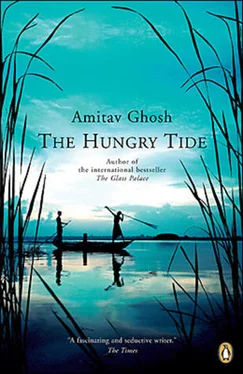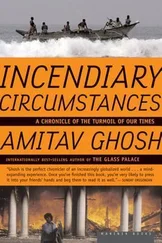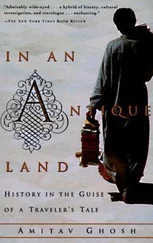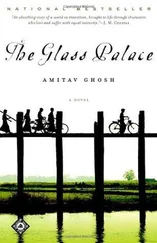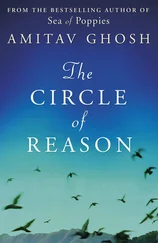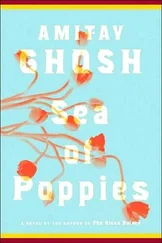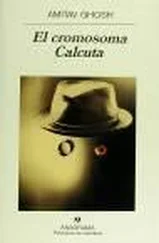But how could she explain this to Fokir?
She made her way to the shelter and found Fokir and the boy fast asleep. They were lying on their sides, with Tutul’s small form nested inside the larger curve of his father’s body. The boy, she noticed, had a slight pudginess that contrasted sharply with his father’s near-skeletal leanness: Fokir was all muscle and bone, a male anatomy reduced to its essentials. Was the boy better fed than his father? There was a story here that she wished she understood: Who looked after the boy? Did someone have to deprive himself to make sure Tutul was properly fed?
Their chests were moving in unison as they slept and the rhythm of their breathing reminded her of the pair of dolphins she had been watching earlier. It calmed her to see them sleeping so peacefully — the contrast with her own state of mind could not have been more marked. She hesitated in extending her arm to wake Fokir: Would he be annoyed at being woken from his siesta? Was this when he would demand to leave for home? She noticed a bead of sweat traveling down his temple toward the corner of his eye, and without thinking she put out a finger to flick it away.
He awoke instantly and sat up, rubbing the spot where her fingertip had touched his skin. She backed away in embarrassment. “I’m sorry,” she said. “I didn’t mean —” He shrugged indifferently and dug his fists into his eyes, as though he were trying to rub away the remnants of sleep.
“Look.” She thrust her positioning monitor in front of him and pointed to the screen. “Over here.” To her surprise, his attention was caught immediately. He looked closely as she tried to show him the meaning of the dots and the lines.
The hardest part was to explain the correspondence between their own position and their place on the screen. She tried pointing, in various combinations, to the screen, to herself, to him and the boy. But the purpose was not served: she saw he had grown flustered and realized that her gestures had given him the impression that she wanted him to move closer to her. The misunderstanding disconcerted her and she fetched a sheet of paper, deciding on a change in strategy. Surely it would be easier if she reduced the problem to two dimensions, by drawing a simple diagram with stick figures, like those familiar to every child. The trouble was, she had never been much good at drawing, and now, halfway into the sketch she was brought up short by an unanticipated misgiving. In the past, she had always used a triangular skirt to distinguish her stick women from her men — but this didn’t quite make sense in a situation where the man was in a lungi and the woman in pants. She crumpled up the sheet and would have tossed it away if Fokir hadn’t taken it from her hands, to save for kindling.
With her next drawing she started with the outlines of the landscape, sketching in the curve of the shore before indicating their own position. Just as she had thought, the reduction to two dimensions made all the difference: once she had shown him how the diagram corresponded with the lines on the monitor’s screen, the rest was easy. It took only a few strokes of her pencil to convey that she needed him to row the boat in parallel lines over a quadrant shaped roughly like a triangle, with its apex almost touching the far shore.
She had expected some reluctance, and possibly even resistance.
But there was none. On the contrary, he seemed quite pleased and went so far as to rouse Tutul with a cheerful shout. It was the prospect of traversing the water in straight lines that seemed to enthuse him most — and she discovered why when he pulled a roll of line out of the hold. Evidently he wanted to use this opportunity to do some fishing.
But the line puzzled her; in all the time she had spent on Asian rivers she had never seen its like. It was made of thick, strong nylon, and all along its length, at intervals of a yard or so, were weights — small fragments of broken tile. Stranger still, there were no hooks. Instead, spaced between the weights were bits of fish bone and dried cartilage, tied to the line with cord. It was difficult to see how the tackle worked: the expectation seemed to be that a fish would just attach itself to the line and permit itself to be reeled in. But surely no fish would do that. Then what could he be fishing for? She was at a loss for an answer. It was clear in any event that the line presented no threat to the dolphins and she could see no reason to object to his laying it so long as the boat kept to the right course.
She went back to the bow and readied herself to proceed with her mapping. With her monitor in hand she directed Fokir to the position from which they were to start. Then, just as Tutul was dropping the first weight in the water, she dipped the echo sounder and pressed the button.
The initial run was about a half mile long, and by the time they reached the end the whole line had been paid out. It was after they had turned to retrace their course that Piya discovered what the line was for: it was pulled in with a live crab hanging on to every ninth or tenth morsel of bait. The creatures had snapped their claws on the cartilage and would not let go. Fokir and Tutul had only to peel them off with a net and drop them into a pot filled with leaves. The sight made Piya laugh: so this was where the word “crabby” came from, a creature so stubborn that it would rather be captured than let go?
It took only a few more runs to confirm Piya’s guess that the dolphins had congregated in a declivity. Her soundings showed that the riverbed dipped by a good fifteen to twenty feet there, more than enough to provide for the dolphins’ comfort when the water was running low.
But it was not just for dolphins that the pool was a hospitable habitat: crabs too seemed to flourish there, and Fokir’s catch grew steadily with each successive run. At the start she had thought they might end up disrupting each other’s work — that her soundings would get in the way of his fishing or the other way around. But to her surprise no such difficulties arose: the stops required for the laying of the line seemed to be ideally timed for the taking of soundings. What was more, the line acted like a guide rail, keeping the boat on a straight and unvarying tack, and at the end of each run it led them right back to the precise starting point. In other circumstances Piya would have had to use the Global Positioning System to be sure of this, but here the line served the same purpose. She needed her monitor only to make sure that each run began at a point fifteen feet farther along the quadrant. This was just as much to Fokir’s advantage as it was to hers, since it ensured that his line never fell twice in the same place.
It was surprising enough that their jobs had not proved to be utterly incompatible — especially considering that one of the tasks required the input of geostationary satellites while the other depended on bits of shark bone and broken tile. But that it had proved possible for two such different people to pursue their own ends simultaneously — people who could not exchange a word with each other and had no idea of what was going on in one another’s heads — was far more than surprising: it seemed almost miraculous. Nor was she the only one to remark on this: once, when her glance happened accidentally to cross Fokir’s, she saw something in his expression that told her that he too was amazed by the seamless intertwining of their pleasures and their purposes.
When the crab pot was full, Fokir covered its mouth with an aluminum plate and passed it to her so she could release the catch into the hold. Looking in, she saw that there were some fifteen crabs inside the pot, eyeing her balefully, snapping their claws. When she tipped the pot over they tumbled out in a chain and disappeared into the hold with an angry outburst of clicking and clattering. The unlikely eloquence of the sound drew a laugh from Piya. Her birthday was in July and she had often wondered why the ancients had included a crab in the zodiac when there were so many other, more interesting animals to choose from. But now, as she watched the creatures scuttling about in the hold, she found herself wishing that she knew more about crabs. She recalled a class in which the teacher had demonstrated how some kinds of crabs actually laundered the mud they lived in, scrubbing it grain by grain. Their feet and their sides were lined with hairs that formed microscopic brushes and spoons. They used these to scrape off the diatoms and other edible matter attached to each grain of sand. They were a sanitation department and a janitorial team rolled into one: they kept the mangroves alive by removing their leaves and litter; without them the trees would choke on their own debris. Didn’t they represent some fantastically large proportion of the system’s biomass? Didn’t they outweigh even the trees and the leaves? Hadn’t someone said that intertidal forests should be named after crabs rather than mangroves since it was they — certainly not the crocodile or the tiger or the dolphin — who were the keystone species of the entire ecosystem?
Читать дальше
Конец ознакомительного отрывка
Купить книгу
